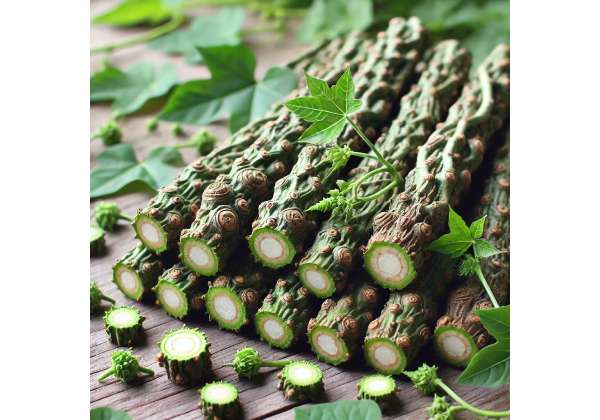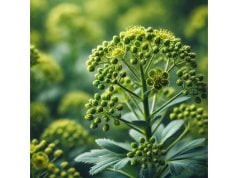
Giloy, also known as Tinospora cordifolia, is a revered herb in Ayurvedic medicine celebrated for its potent healing properties and immune-enhancing benefits. With a long history of traditional use, Giloy is prized for its ability to combat infections, reduce inflammation, and support overall vitality. This comprehensive guide explores Giloy’s botanical characteristics, delves into its unique phytochemistry, and examines its wide range of health benefits and practical applications. Whether you are seeking natural immune support, digestive aid, or a natural anti-inflammatory remedy, this article provides in-depth insights to help you make informed decisions about incorporating Giloy into your wellness routine.
Table of Contents
- Botanical Profile & Identification
- Phytochemical Composition & Active Compounds
- Health Benefits & Therapeutic Properties
- Uses, Safety & Practical Applications
- Scientific Research & Significant Studies
- Frequently Asked Questions (FAQ)
Giloy: Botanical Profile & Identification
Giloy (Tinospora cordifolia) is a climbing shrub that is widely distributed across the Indian subcontinent and parts of Southeast Asia. Botanically classified under the Menispermaceae family by some experts and the family Apocynaceae by others, its exact taxonomic position has been the subject of debate among botanists. Despite this, its distinctive morphological features have ensured its prominence in traditional medicine and horticulture.
Taxonomy and Botanical Characteristics
- Kingdom: Plantae
- Order: Ranunculales (or alternative orders based on differing taxonomic interpretations)
- Family: Menispermaceae / Apocynaceae
- Genus: Tinospora
- Species: Tinospora cordifolia
Giloy is characterized by its heart-shaped, lobed leaves that exhibit a glossy, dark green surface with prominent veining. The plant’s stems are thick, succulent, and woody, often bearing a slightly rough texture with longitudinal ridges. These stems, which can reach several feet in length, are not only a key identifier but also the primary source of the herb’s medicinal constituents. Its inconspicuous small, yellowish flowers and subsequent berry-like fruits add to the plant’s modest yet intriguing reproductive cycle.
Growth Conditions and Natural Habitat
Giloy thrives in tropical and subtropical climates, flourishing in regions that experience a monsoon season with abundant rainfall. It prefers well-drained soils enriched with organic matter, though it is known for its resilience and ability to adapt to varied soil conditions. Traditionally found climbing on other vegetation or even along fences and rocky terrains, Giloy’s vigorous growth habit makes it a robust candidate for both wild harvesting and cultivated herbal gardens.
In its natural habitat, Giloy plays an integral role in local ecosystems. Its sprawling vines offer shelter to various small animals and insects, contributing to biodiversity. Additionally, the plant’s ability to thrive in less-than-ideal soil conditions underscores its significance in soil conservation and reforestation efforts in degraded landscapes.
Morphological and Anatomical Insights
The stem of Giloy is of particular interest to researchers due to its high concentration of bioactive compounds. The bark is smooth in younger stems and gradually becomes rougher with age, accumulating a range of chemical constituents that contribute to the herb’s medicinal efficacy. The leaves, although simple in structure, contain essential oils and polyphenols that enhance the plant’s protective mechanisms against environmental stressors.
Giloy’s reproductive structures, while not as visually striking as those of ornamental plants, serve a crucial role in its propagation. The small, fragrant flowers attract a variety of pollinators, ensuring the production of fruit and the subsequent dispersal of seeds. This reproductive strategy not only sustains wild populations but also facilitates the spread of the herb across various regions.
Traditional and Modern Cultivation Practices
Historically, Giloy has been propagated through both seed and stem cuttings, with traditional farmers often relying on the latter method due to its higher success rate in preserving the plant’s medicinal properties. Modern agricultural techniques have further refined these methods, incorporating organic fertilizers and sustainable cultivation practices to boost yield and potency.
The botanical study of Giloy has led to a greater understanding of its adaptive features, which in turn has influenced modern breeding programs aimed at enhancing its therapeutic profile. Ongoing research continues to explore the genetic diversity within Tinospora cordifolia, aiming to identify superior cultivars that offer increased concentrations of beneficial compounds.
Through centuries of observation and study, Giloy has earned its reputation not only as a resilient and adaptable plant but also as a cornerstone of traditional healing practices. Its unique botanical characteristics lay the foundation for its diverse applications, making it a subject of continued interest for both herbalists and modern scientists alike.
Giloy: Phytochemical Composition & Active Compounds
Giloy’s medicinal prowess is largely attributed to its rich and diverse phytochemical profile. The herb is a veritable reservoir of bioactive compounds that work synergistically to promote health and wellness. Advanced analytical techniques have enabled researchers to identify and quantify these compounds, which include alkaloids, glycosides, steroids, diterpenoids, and various antioxidants.
Below is a detailed breakdown of the key active compounds found in Giloy:
- Alkaloids
Giloy contains several alkaloids, such as berberine, palmatine, and choline derivatives. These compounds are known for their antimicrobial and immunomodulatory properties. Alkaloids help stimulate the immune system, promote detoxification, and may contribute to the herb’s antipyretic (fever-reducing) effects. - Glycosides
The herb is rich in glycosides like tinocordiside and cordifolioside. Glycosides in Giloy play a vital role in enhancing cellular energy metabolism and exhibit anti-inflammatory properties. They are also implicated in improving cardiovascular health by promoting healthy blood circulation. - Steroids and Diterpenoids
Giloy contains a range of steroidal compounds and diterpenoids, which are recognized for their anti-inflammatory and antioxidant activities. These compounds contribute to the herb’s ability to modulate immune responses and reduce oxidative stress, thus protecting the body against chronic diseases. - Phenolic Compounds and Flavonoids
The presence of phenolic compounds and flavonoids such as quercetin and kaempferol in Giloy adds to its antioxidant capacity. These molecules scavenge free radicals, thereby mitigating cellular damage and lowering the risk of inflammation-related disorders. - Lactones and Polysaccharides
Recent studies have identified lactones and bioactive polysaccharides in Giloy, which further enhance its immunomodulatory effects. Polysaccharides, in particular, are credited with stimulating macrophage activity and supporting the body’s natural defense mechanisms.
Synergistic Effects and Bioavailability
The therapeutic effects of Giloy are not derived from a single compound but rather from the synergistic interaction between its myriad constituents. For instance, the combined action of alkaloids and glycosides may potentiate the herb’s overall anti-inflammatory response, while the mix of phenolic compounds and flavonoids boosts its antioxidant defense. This synergy not only enhances the herb’s efficacy but also contributes to its safety profile, as the presence of multiple active compounds can mitigate potential side effects when consumed in appropriate doses.
Extraction and Standardization
Advancements in extraction techniques have enabled the isolation of Giloy’s bioactive compounds in more concentrated forms. Methods such as ethanol extraction, supercritical fluid extraction, and cold-pressing have been utilized to create standardized extracts that ensure consistent potency and efficacy. These extracts are now widely used in the formulation of herbal supplements, where precise dosages can be administered to target specific health conditions.
Factors Influencing Phytochemical Content
The concentration of active compounds in Giloy can vary significantly based on several factors, including:
- Geographical Location: Soil composition, climate, and regional agricultural practices can influence the phytochemical profile.
- Harvesting Time: The stage of plant maturity at the time of harvest plays a critical role in determining the concentration of bioactive constituents.
- Cultivation Practices: Organic farming and traditional cultivation methods are often associated with higher levels of beneficial compounds compared to intensive farming practices.
Research and Future Directions
Ongoing research continues to unveil the complex interactions between Giloy’s active compounds. Studies are increasingly focusing on the molecular mechanisms underlying its immunomodulatory and anti-inflammatory effects. With the growing demand for natural remedies, future research may lead to the development of novel therapeutic agents derived from Giloy, further cementing its role in integrative medicine.
In summary, the intricate phytochemical composition of Giloy not only underpins its longstanding reputation in traditional medicine but also offers promising avenues for modern therapeutic applications. Its diverse array of active compounds, working in harmony, provides a robust foundation for the herb’s many health benefits, making it a subject of continued interest for researchers and herbal practitioners alike.
Giloy: Health Benefits & Therapeutic Properties
Giloy is celebrated across traditional medicine systems for its extensive range of health benefits. As a powerful adaptogen, this herb helps the body cope with stress and enhances overall resilience. Its bioactive compounds provide a robust defense against infections, reduce inflammation, and contribute to overall well-being. The following sections delve into the many therapeutic properties of Giloy, backed by both ancient wisdom and modern scientific research.
Immune System Enhancement
One of the most renowned benefits of Giloy is its ability to bolster the immune system. By stimulating the production and activity of white blood cells, Giloy helps the body fend off infections ranging from common colds to more severe viral and bacterial challenges. Its immunomodulatory properties not only enhance innate immunity but also promote a balanced immune response, reducing the risk of autoimmune disorders. Regular consumption of Giloy, whether as a decoction, powder, or capsule, can help maintain optimal immune function, particularly during seasonal changes and periods of stress.
Anti-Inflammatory and Antipyretic Effects
Chronic inflammation is a common underlying factor in many diseases, including arthritis, cardiovascular disorders, and metabolic syndrome. Giloy’s potent anti-inflammatory properties help in reducing systemic inflammation, thereby alleviating symptoms associated with inflammatory conditions. Additionally, its antipyretic (fever-reducing) properties make it an effective remedy for managing febrile conditions. The herb works by modulating inflammatory cytokines and inhibiting the pathways that lead to fever and pain, providing relief without the harsh side effects often associated with synthetic drugs.
Antioxidant Activity and Detoxification
The rich blend of phenolic compounds and flavonoids in Giloy confers strong antioxidant properties that protect cells from oxidative stress. By neutralizing free radicals, Giloy helps prevent cellular damage and supports the body’s natural detoxification processes. This antioxidant activity is crucial in reducing the risk of chronic diseases, such as cancer and heart disease, by maintaining cellular integrity and promoting healthy aging.
Support for Metabolic Health
Emerging evidence suggests that Giloy may play a role in managing blood sugar levels and supporting metabolic health. Some studies indicate that its bioactive compounds help improve insulin sensitivity and regulate glucose metabolism, which is beneficial for individuals with diabetes or metabolic syndrome. By promoting balanced blood sugar levels, Giloy contributes to overall energy regulation and metabolic homeostasis.
Hepatoprotective and Digestive Benefits
Giloy has long been used in traditional medicine to support liver health. Its hepatoprotective properties help in detoxifying the liver and protecting it against damage from toxins and environmental pollutants. Furthermore, Giloy aids digestion by stimulating the secretion of digestive enzymes, thereby enhancing nutrient absorption and alleviating gastrointestinal discomfort. These properties make it a valuable remedy for maintaining a healthy digestive system and promoting overall vitality.
Adaptogenic and Stress-Relief Properties
In today’s fast-paced world, managing stress is crucial for maintaining good health. Giloy acts as an adaptogen, helping the body adapt to physical and mental stress. It supports adrenal function and helps stabilize cortisol levels, which can reduce anxiety, fatigue, and stress-related disorders. This adaptogenic quality makes Giloy a popular choice for those looking to maintain mental clarity and emotional balance during challenging times.
Skin and Joint Health
The anti-inflammatory and antioxidant properties of Giloy extend to its benefits for skin and joint health. Topical applications of Giloy extracts have been used traditionally to soothe skin irritations, promote wound healing, and reduce the signs of aging. Additionally, its systemic anti-inflammatory effects can help alleviate joint pain and stiffness, making it a supportive remedy for conditions like arthritis.
Holistic Well-being and Longevity
Beyond addressing specific health issues, Giloy is valued for its overall contribution to holistic well-being. It is often integrated into daily health regimens to boost energy, enhance mental clarity, and promote longevity. Its multifaceted benefits support the body’s natural healing processes, making it a cornerstone of preventive healthcare and an essential component of a balanced lifestyle.
By harnessing the diverse therapeutic properties of Giloy, individuals can benefit from its natural ability to restore balance and promote optimal health. Whether used as part of a daily wellness routine or as a targeted remedy for specific conditions, Giloy offers a natural and effective solution for enhancing the quality of life.
Giloy: Uses, Safety & Practical Applications
Giloy’s versatility extends beyond its impressive health benefits. For centuries, it has been used in various forms—from decoctions and powders to tinctures and capsules—making it an integral part of traditional Ayurvedic and herbal remedies. This section outlines the diverse applications of Giloy, provides practical usage tips, and discusses essential safety considerations.
Medicinal Applications
- Immune Booster:
Giloy is perhaps best known for its immune-enhancing properties. It is often used as a daily tonic to fortify the body’s defenses against infections. Regular consumption can help reduce the frequency of common illnesses and support recovery during periods of stress. - Fever and Infection Management:
Traditionally, Giloy decoctions are used to reduce fever and manage symptoms of infections. Its antipyretic and antimicrobial properties make it a trusted remedy for alleviating symptoms associated with flu, colds, and other viral infections. - Digestive Aid:
By stimulating digestive enzymes and promoting better nutrient absorption, Giloy is used to treat digestive disorders such as constipation, bloating, and indigestion. Its hepatoprotective properties also support liver detoxification, aiding in overall digestive health. - Anti-inflammatory and Joint Support:
The herb is widely utilized to manage inflammatory conditions. Its natural anti-inflammatory compounds help reduce joint pain and stiffness, making it beneficial for individuals suffering from arthritis and other inflammatory disorders. - Metabolic and Cardiovascular Support:
Emerging research suggests that Giloy may help regulate blood sugar levels and improve lipid profiles, thus supporting metabolic health. Its use as a complementary remedy in managing diabetes and cardiovascular conditions is gaining popularity.
Culinary and Cosmetic Uses
While predominantly used for its medicinal properties, Giloy is also incorporated into culinary and cosmetic applications:
- Herbal Teas and Smoothies:
Giloy powder can be blended into teas or smoothies, offering a convenient way to incorporate its benefits into your daily diet. Its slightly bitter taste is often balanced with natural sweeteners or mixed with other herbs. - Cosmetic Preparations:
Due to its antioxidant and anti-inflammatory properties, Giloy extracts are increasingly used in skincare formulations. These preparations help soothe irritated skin, reduce inflammation, and promote a youthful appearance by protecting against oxidative stress.
Dosage Recommendations and Preparation Methods
- Decoctions:
One of the most traditional methods of consumption is to prepare a decoction by boiling 5–10 grams of Giloy stem in water for 15–20 minutes. This concentrated liquid can be consumed once or twice daily. - Powdered Form:
Giloy powder is available in capsule form or as a loose powder that can be mixed into warm water or herbal teas. Standard dosages typically range from 1–3 grams per day, but individual requirements may vary. - Tinctures and Extracts:
For a more concentrated form, Giloy tinctures are prepared by soaking the herb in alcohol or another solvent. These extracts allow for precise dosing and are often used for acute conditions under professional supervision.
Safety Considerations and Potential Side Effects
While Giloy is generally considered safe for most users, certain precautions should be observed:
- Proper Identification and Quality:
Always ensure that you are purchasing Giloy from reputable sources. Adulterated or low-quality products may not provide the desired therapeutic effects and could contain contaminants. - Pregnancy and Lactation:
Pregnant or breastfeeding women should consult a healthcare provider before using Giloy, as its effects during these periods are not fully established. - Allergic Reactions:
Although rare, some individuals may experience allergic reactions to Giloy. It is advisable to perform a patch test or start with a lower dose if you are new to the herb. - Interactions with Medications:
Giloy may interact with certain prescription medications, particularly those affecting the immune system or blood sugar levels. Individuals on such medications should seek professional guidance prior to incorporating Giloy into their regimen.
Practical Tips for Incorporation
- Start Gradually:
If you are new to Giloy, begin with small doses to gauge your body’s response. Gradually increase the dosage as needed while monitoring for any adverse effects. - Combine with a Balanced Diet:
For optimal results, use Giloy as part of a comprehensive wellness strategy that includes a balanced diet, regular exercise, and adequate rest. - Consult with Experts:
Before beginning any herbal regimen, especially if you have pre-existing health conditions, consult with a qualified herbalist or healthcare provider to determine the appropriate dosage and form. - Storage:
Store Giloy in a cool, dry place away from direct sunlight. If using powdered or extracted forms, follow the manufacturer’s storage instructions to maintain potency and effectiveness.
Through proper use and adherence to safety guidelines, Giloy can be a valuable addition to your natural health toolkit. Its diverse applications, from immune support to digestive aid and beyond, make it a truly versatile herb that continues to garner acclaim in both traditional and modern medicine.
Giloy: Scientific Research & Significant Studies
Over recent decades, a growing body of scientific research has sought to validate the traditional uses of Giloy. Numerous studies have been conducted to explore its immunomodulatory, anti-inflammatory, and antioxidant properties. Below is a detailed review of some of the most significant and recent studies related to Giloy:
- Study on Immunomodulatory Effects (2017)
Journal: Journal of Ethnopharmacology
Researchers conducted a study to assess the immunomodulatory effects of Tinospora cordifolia extracts on animal models. The study demonstrated that Giloy significantly increased the production of white blood cells and enhanced the activity of macrophages. These effects were attributed to the presence of alkaloids and glycosides, which modulate the immune response by activating specific signaling pathways. The study concluded that regular consumption of Giloy could bolster the immune system and provide protection against infections, thereby substantiating its traditional use as an immune booster. - Investigation of Anti-Inflammatory Properties (2018)
Journal: Phytotherapy Research
In this study, researchers evaluated the anti-inflammatory effects of Giloy in rodent models with induced inflammatory conditions. The findings indicated a significant reduction in inflammatory markers, such as TNF-α and IL-6, following the administration of Giloy extracts. The study attributed these effects to the synergistic action of its phytoconstituents, particularly the diterpenoids and phenolic compounds. The research suggests that Giloy may serve as an effective natural alternative for managing chronic inflammatory diseases, with a lower risk of adverse side effects compared to conventional non-steroidal anti-inflammatory drugs (NSAIDs). - Research on Hepatoprotective Effects (2019)
Journal: Indian Journal of Experimental Biology
This study focused on evaluating the hepatoprotective potential of Giloy in a chemically induced liver injury model. The results revealed that treatment with Giloy extracts significantly reduced liver enzyme levels and improved histopathological outcomes in damaged liver tissues. The protective effects were linked to the herb’s antioxidant capacity and its ability to scavenge free radicals, thereby mitigating oxidative stress. These findings support the traditional use of Giloy in detoxifying the liver and promoting overall liver health. - Study on Glycemic Control and Metabolic Benefits (2020)
Journal: Journal of Ayurveda and Integrative Medicine
A clinical trial investigated the impact of Giloy supplementation on glycemic control among individuals with type 2 diabetes. The study found that participants receiving a standardized dose of Giloy extract experienced improved blood glucose regulation and a reduction in HbA1c levels over a 12-week period. The beneficial effects were attributed to the herb’s ability to enhance insulin sensitivity and modulate carbohydrate metabolism. This research provides promising evidence for the incorporation of Giloy as a complementary therapy in the management of diabetes and metabolic disorders. - Neuroprotective and Cognitive Function Study (2021)
Journal: Frontiers in Pharmacology
Emerging research has begun to explore the neuroprotective properties of Giloy. In this study, animal models exposed to neurodegenerative stressors were treated with Giloy extracts. The results indicated improved cognitive function, reduced neuronal damage, and decreased markers of oxidative stress in brain tissues. The study proposes that the antioxidant and anti-inflammatory effects of Giloy may help mitigate the progression of neurodegenerative diseases, highlighting its potential role in supporting cognitive health and longevity.
Each of these studies contributes to the growing scientific evidence that supports the traditional uses of Giloy. They underscore the herb’s multifaceted therapeutic potential, ranging from immune enhancement and anti-inflammatory activity to metabolic regulation and neuroprotection. As research continues, Giloy is poised to become an integral component of integrative medicine, bridging the gap between ancient wisdom and modern science.
Giloy: Frequently Asked Questions (FAQ)
What are the primary benefits of Giloy?
Giloy is widely recognized for its immune-boosting, anti-inflammatory, and antioxidant properties. It helps enhance overall immunity, reduces inflammation, supports liver health, and aids in maintaining balanced blood sugar levels.
How is Giloy typically consumed?
Giloy can be consumed in various forms, including decoctions, powders, capsules, and tinctures. Decoctions and powders are traditional methods, while standardized extracts offer a concentrated dose for targeted health benefits.
Are there any known side effects of using Giloy?
Giloy is generally safe when used appropriately. However, some individuals may experience mild gastrointestinal discomfort or allergic reactions. It is advisable to consult a healthcare provider, especially if you are pregnant, breastfeeding, or on medication.
Can Giloy help with chronic inflammatory conditions?
Yes, research suggests that Giloy’s anti-inflammatory properties can help manage chronic inflammatory conditions. Its bioactive compounds work synergistically to reduce inflammatory markers, providing relief from conditions like arthritis.
Is there scientific evidence supporting the benefits of Giloy?
Multiple studies have validated Giloy’s therapeutic effects, including its immunomodulatory, hepatoprotective, and metabolic benefits. These findings are documented in reputable journals and underscore its value in both traditional and modern medicine.
Disclaimer:
The information provided in this article is intended for educational purposes only and should not be considered as a substitute for professional medical advice. Always consult a healthcare provider before making any changes to your treatment or health regimen.
Feel free to share this article on Facebook, X (formerly Twitter), or your preferred social media platforms. Spread the knowledge and benefits of Giloy with your community!










